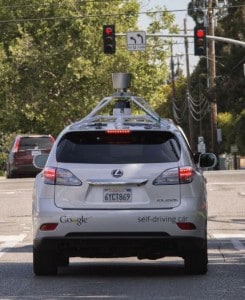 Google is expanding its self-driving car fleet while the California Department of Motor Vehicles is providing more information about self-driving car collisions in California. The information provided, however doesn’t clearly show the cause of the accidents, notes a consumer advocacy group.
Google is expanding its self-driving car fleet while the California Department of Motor Vehicles is providing more information about self-driving car collisions in California. The information provided, however doesn’t clearly show the cause of the accidents, notes a consumer advocacy group.
This week, Google had 48 permits for self-driving vehicles, while a month earlier, on May 15, DMV had issued Google just 23 permits. The new permits are for the prototype marshmallow-like LSVs that are being tested on private roads now and will be on public roads this summer.
Eight companies have permission to test 82 self-driving cars in California. After Google Tesla has the most permits at 12. Other companies with permits are Volkswagen Audi, Mercedes Benz, Delphi, Bosch and Nissan.
In May, the Associated Press uncovered four accidents in self-driving cars three Lexus models with Google technology and one Dephi self-driving Audi out of the fifty self-driving cars in California. Google then admitted to total of eleven self-driving accidents. The Associated Press and Consumer Watchdog request full disclosure of the details of the accidents. However, the DMV then said it treated driverless car accident reports confidentially and would not release them.
John M. Simpson, Consumer Watchdog’s Privacy Project director asked at the recent Google’s shareholders meeting that Google release official accident reports. Then Google began offering monthly reports about robot car testing that included a synopses of crashes.
The California Department of Motor Vehicles changed its policies and will now release accident reports about crashes involving self-driving cars that are being tested on public roads.
Roger J. Sato, Senior Staff Counsel stated that DMV at first did not release the reports based on Vehicle Code provisions that require accident reports concerning traffic injuries or fatalities to remain confidential.
After pressure from the media, DMV determined that it was possible to release the factual information related to the autonomous vehicle reports and keep the personal information of the drivers involved in the accidents and other information not disclosable by law confidential.
Reports are available however the names of the drivers and the VIN numbers will not be released. The DMV reports released gave the date and time of the accidents and the make and model of the other cars. The details of the accidents are sparse.
“The information released by the DMV offers more details than Google’s own reports,” said John Simpson, “However, we need to know why the accidents happened.”
Consumer Watchdog wants to know more details. The accidents could be caused by the way the self-driving cars are moving or stopped. Say the cars are stopping for yellow lights which a human would not do or staying stopped for longer times than the drivers behind them expect, the style of driving could be contributing to problem.
“It’s not enough to have the companies who are testing the cars to report the incidents,” said Simpson who noted that there should be documentation that is impartial.
The self-driving rules issued by the DMV require that the “Manufacturer reports to DMV any accident involving a test vehicle or any situation where the autonomous technology disengages during operation and maintains $5 million insurance or surety bond.”
A Google spokeswoman could not tell the Associated Press whether the company had filed DMV reports on any of the first eight accidents, and said she could not provide damage estimates because repairs were done in-house, without a bill.
Since, May the number of Google crashes now stands at 13. In one crash, involving a Delphi car, the car was hit by another car while stopped at a light in manual driving mode. Chris Urmson, Google’s Self-Driving car Director, claimed that none of the Google cars were at fault.
A question we at AUTO Connected Car News ask, “If there are cameras on these self-driving cars, why aren’t they required to turn over video of the collisions?” Say for example, the Google self-driving car is stopped at a light, the front camera captures that the light changes to green, the car does not move and the rear camera shows very far behind the car is a driver who sees the light is green and doesn’t brake. Then who’s at fault?
Consumer Watchdog is advocating for there to be a steering wheel, brake pedal and accelerator in each car, so that human drivers can take over if there is trouble. They also want to protect private information gathered by the self-driving robot cars from being used for any purpose other than driving the cars.
A Boston Consulting Group study found that for those who wouldn’t buy an an autonomous vehicle, the biggest considerations appear to be reliability, cyber security, and uncertainty about AV interactions with other vehicles on the road.
Men and younger people prefer self-driving cars, while women and most people are skeptical.
Daimler, Tesla, Audi and Delphi appear to winning self-driving connected car race in the second quarter of this year.
U.S. Transportation Secretary Anthony Foxx at announced support for speeding up the process for new connected car technology and autonomous self-driving cars.